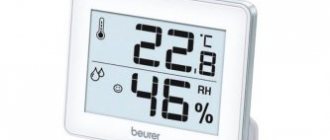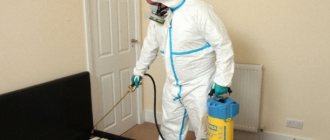Optimal air humidity
We all know that the human body is 70% water.
Therefore, it is vital for us that the air around us is not too dry. Otherwise, you cannot avoid symptoms such as dry mouth, constant thirst, feeling tired, nasal congestion, snoring during sleep and coughing. All these signs indicate that you need to increase the humidity in the room. There are many ways to do this. But first, let’s look at the simplest method of how to find out what the air humidity is in your home right now. To do this, you need to take a glass glass, pour water into it and put it in the refrigerator. When the temperature of the water becomes the same as inside the refrigerator, the glass must be placed in the room. It is advisable to place it away from heaters and radiators.
If after 5-10 minutes the walls of the glass dry out, the humidity in the room is very low. If the condensation remains - medium, but if moisture flows down the walls of the glass - the humidity is high. This is the so-called express method, but in order to know exactly what your humidity is at any moment, it is advisable to have an indoor air humidity meter at home.
It will reliably monitor the atmosphere of your home, showing in time what measures should be taken. If the humidity is 70-90%, the room can be ventilated; if it is 20-40%, it must be humidified. After all, high humidity also should not be present in the house all the time, this is fraught with the development of fungus and mold. The most optimal humidity level that needs to be maintained in an apartment is 50-60%. If this threshold is exceeded, the development of fungi and the appearance of dust mites is possible. If the humidity is very low, this is fraught with bacteria, viruses, allergies and diseases of the respiratory system.
Stabilization of indoor humidity levels
From everything written above, we know that for the health of humans, animals and plants, the optimal humidity level is 45%. We also found out how to measure the concentration of water vapor in the air, and now we will look at what to do if the room is too damp or dry.
How to increase humidity in an apartment
An air humidifier is the most common way to normalize the indoor microclimate
If the air in the room is too dry, you can correct the situation in several simple and accessible ways:
- using household humidifiers;
- increasing the number of indoor plants;
- installation of an aquarium or decorative pond;
- regular ventilation of premises;
- carrying out wet cleaning;
- minimizing the use of heating appliances, air conditioners, computers, televisions, etc.;
- periodically humidifying the air by spraying water from a spray bottle;
- hanging wet towels on heating radiators in winter.
If special devices are used in the room, then it would be useful to find out how long the humidifier in the room should work. Such information is usually indicated in the instructions for the device.
Related article:
Reducing indoor humidity
A dehumidifier and open windows in summer help get rid of excess moisture in the apartment.
High humidity is just as harmful as too dry air. Therefore, we will consider ways that will help reduce the concentration of moisture in the room. So, to normalize air humidity, you need to do the following:
- ventilate the premises after taking a bath, washing or cooking;
- It is not recommended to dry clothes indoors - it is best to dry them outside. If this is not possible, then it is better to do this in a spare room, opening the window;
- Do not curtain windows in rooms with high humidity in summer;
- use dehumidifiers;
- if high humidity is associated with faults in the water supply or plumbing fixtures, then they need to be fixed urgently;
- turn on heating devices or air conditioners.
Related article:
We offer a video explaining how to remove excess moisture from the air using a household dehumidifier:
Watch this video on YouTube
Features of microclimate measurements
The microclimate parameters in the room are measured taking into account the actual temperature outside. Regulatory requirements depend on it. In winter, the relative humidity can be reduced to 30%, while in summer it should not fall below 35%.
In production, educational institutions, and public organizations, microclimate indicators are monitored at least 3 times a day. The peculiarities of the labor process, the presence of heating and ventilation systems are taken into account. Only by analyzing all the factors can you identify the main problems and take the right measures to eliminate them.
Carrying out measurements of microclimate parameters is necessary when assessing working conditions at an enterprise or organization. There are also programs in production, according to which the values of external factors must be measured in order to know whether they meet the requirements of the technological process.
At home, you can also control microclimate parameters. For this purpose, universal devices or separate devices are used. Pressure is measured with a barometer, temperature with an alcohol or electronic thermometer, and humidity with a hygrometer.
Effects of high humidity
Delving into the topic of how to determine the air humidity in an apartment, you should clearly understand the consequences of deviation of this indicator in both one and the other direction. Inconsistencies are a warning sign.
The first sign of high humidity in an apartment is condensation on the windows. At the same time, all things and furniture in the room are exposed to dampness. Then a specific musty smell appears, and fungus begins to develop in the corners and on interior items. Mold is an unsafe neighbor for humans. It causes serious deviations in well-being and causes a number of ailments.
The consequences of high humidity can be allergies or even asthma, and a decrease in the functions of the immune system. Diathesis sometimes occurs in children. Headaches and diseases of the cardiovascular system are also a consequence of an unsuitable microclimate. Bronchitis and otitis media also develop in similar conditions. Cancer cells also develop faster in high humidity conditions.
Types of measuring instruments
Measuring devices are required to set up the ventilation system.
Before purchasing a measuring device, you need to decide where exactly the measurement will be made. It can occur both in the ventilation grille and directly in the air duct. You should also be aware of some of the requirements that apply to the stream. For example, the speed of the flow or its temperature must correspond to standard indicators.
Air measurements in the apartment are carried out with the following devices:
- Thermal anemometer. Used to measure air speed. A special sensor is heated to a certain temperature and placed under a moving stream. Next, measure the time during which the sensor cools down. This will be the flow speed.
- Ultrasonic anemometer. The device is placed in the air flow. Velocity is measured by capturing sound frequencies at different points in the duct.
- Vane anemometer. The flow speed is determined by a moving impeller.
- Pitot tube. High-quality digital equipment is used for measurements. The tube is placed in a specific area where static and total pressure is measured.
- Balometer. It determines the air flow that passes through a certain section of the duct.
Household dehumidifiers
What humidity should be in the house? The optimal level is 40-60% or slightly higher if there is a child in the apartment. If the indicators are greatly exceeded, various health problems may arise. To prevent this, if necessary, household dehumidifiers are used, which can be stationary or mobile. The performance of the device is determined by the amount of water absorption per day in liters.
The dryer can be adsorption or compressor. Humid air enters the compressor rooms through fans and then passes through the evaporator. The moisture settles in the form of condensation, ending up in a special receiver. The heated air exits through another hole in the device. The adsorption apparatus has no moving parts, operates completely silently and does not consume energy. This dehumidifier absorbs moisture using an adsorbent inside. Moisture-saturated filler must be changed periodically.
The Tale of a Little Wizard and a Magic Bucket
The concept of air humidity is easy to explain with the help of a fairy tale.
In a certain kingdom there lived a little wizard. His name was Air. And he had a magic bucket.
The magic was that the size of the bucket depended on the temperature. The higher the temperature, the larger the bucket became, increasing in size.
Note: In this analogy, absolute humidity is the amount of water poured into the bucket. And relative humidity is the proportion that the poured water occupies in relation to the entire volume of the bucket.
Suppose that at a certain temperature the volume of the bucket is 10 liters. Pour 5 liters of water into a bucket. This is half a bucket, that is, the relative humidity will be 50%. Since 5/10 = 0.50 = 50%
We do not change the amount of water poured, which means that the mass and volume of water does not change.
Let's say the temperature has increased. The size of the bucket will increase with increasing temperature. Let's assume that the bucket has grown so much that its volume is now 15 liters.
This means that now the relative humidity will be equal to
5/15 = 0,33 = 33%
Rice. 8. As temperature increases, relative humidity decreases
Let us now assume that the temperature has dropped. This means that the volume (size) of the bucket will decrease. If, for example, the volume of the bucket decreases to 8 liters, then the relative humidity will be
5/8 = 0,625 = 62,5%
That is, absolute humidity has not changed, but relative humidity has increased.
Rice. 9. As temperature decreases, relative humidity increases
As the temperature drops further, the volume of the bucket will continue to decrease. At a certain temperature, it may happen that the volume of the reduced bucket coincides with the volume of water poured.
Suppose the volume of the bucket decreases to 5 liters. And the amount of water in the bucket is also 5 liters. The relative humidity will be 100%.
5/5 = 1,0 = 100%
The temperature at which the size of the bucket matches the amount of water poured is called the dew point.
Rice. 10. By reducing the temperature of humid air we can achieve steam saturation and dew point. Relative humidity at this temperature will be 100%
If the temperature continues to drop, the magic bucket will continue to shrink. Excess water will spill out. We say in such cases: “precipitation is falling,” or “it is raining.”
Note: Relative humidity cannot exceed 100%. When relative humidity is 100%, excess water vapor from the air condenses, resulting in precipitation - rain or dew.
Ventilation grille flow measurement
The most common instruments are anemometer and hot-wire anemometer.
To simplify the process, as well as to minimize errors, it is worth using additional devices. The simplest of them is a funnel. It has a simple design that allows you to determine the air flow in just one measurement. This feature significantly saves the specialist’s time. In some cases, it is necessary to measure the air temperature in the room to obtain more accurate measurements.
It happens that they need to be produced in difficult places. In such cases, a telescopic probe is used. Thanks to its long base, you can reach difficult places and take measurements both of atmospheric air and directly in the air duct.
To simplify the procedure, it is necessary to purchase those devices that determine the flow rate through automation. The final result is displayed on an electronic display. There is no need to make additional calculations here. The device will show the average number of three measurements. In the absence of these functions, the calculation is carried out independently.
How to measure air humidity in an apartment
Control the microclimate using a hygrometer, a device that measures the humidity in the apartment. There are several types of hygrometers:
- psychrometric - determines the value of relative humidity; to decipher the readings, you need to compare the data with a psychrometric table;
- electronic - very easy to use, data is displayed on the screen as a percentage;
- ceramic - mechanical method of action, based on identifying the level of electrical resistance under the influence of moisture;
- hair - based on the ability of human hair to change length depending on the influence of moisture;
- weight - determines the absolute humidity of the air;
- condensation - the most reliable indicators, the principle of operation is based on the analysis of the total amount of condensate.
If you don’t have a hygrometer, you can find out the information of interest using a room temperature measuring device and an Assmann table. A kind of home psychrometer. Record the room temperature readings from the thermometer, then wrap the tip with a well-wetted cloth and leave for 5 minutes. Having determined the result, calculate the difference between the readings of the dry and wet thermometer; to decipher the value, use the psychrometric table.
If it happens that you don’t have a room thermometer at hand, and you don’t know how to measure humidity, folk methods will come to the rescue. Naturally, these methods will not provide accurate data on the moisture level in the apartment, but they can indicate an increased or decreased microclimate.
- Fill a glass with cold running water and place in the refrigerator for 3 hours. After the specified time has passed, remove the glass and place it in a room away from heat sources. To start the experiment, you should wait 5 minutes, then evaluate the result.
| reduced | average | increased |
| the walls are dry | the walls remained foggy | drops flow down the walls in streams |
- You need a piece of plywood and a spruce branch, the length of which is 30 cm. Fasten the cut to a plywood sheet, mark the place where the loose end ends. Under the influence of moisture, it will change its position; it is necessary to record changes on the sheet daily, checking the readings of the hydrometeorological center. This way you will learn how to determine readings on a homemade moisture meter.
- For the third method you will need a fir cone. Take the pine cone and place it away from heat sources. Under the influence of high air humidity, the scales of the cone will press against each other. And if there is not enough moisture, they will open.
Table: humidity standards in different rooms
Types of hygrometers
Before purchasing an air humidity meter, you need to understand what types exist today.
After all, the purchase will only be successful, accurate and durable if you choose it wisely. Main types of hygrometers
| Mechanical | It occurs most often, but cannot always be verified by the relevant services, so there is likely to be an error in the readings |
| Hair | This type of device can only be found in some laboratories. His work is based on the fact that ordinary human hair, although degreased, reacts to changes in humidity, thereby changing its length |
| Film | Such hygrometers are based on a special organic film that stretches and contracts when exposed to moisture. |
| Psychometric | Simple, highly accurate and cheap - these are the positive aspects that can characterize this temperature and humidity meter |
| Electronic | The most modern and accurate device ever developed. Has three modifications: electrolytic, ceramic and electrolytic with heating |
Which of the presented types to purchase is up to you to choose. In addition, now on sale you can find not only individual air humidity meters in the apartment, but also combined instruments. Thus, room humidifiers with built-in hygrometers, thermohygrometers (measure both temperature and humidity), clocks, both mechanical and electronic, with built-in hygrometer sensors are very common.
Humidity and babies
Children are the most important thing in any full-fledged family.
Particular attention should be paid to the quality of their living conditions. Temperature and humidity are the most important parameters for them that directly affect their health
Any deviations can immediately affect their general condition, and modern doctors today put indoor humidity and a constant flow of fresh air at the forefront in relation to the health of each child.
Deviations from normal humidity can cause respiratory diseases - Photo 11
Air humidification for children's health - Photo 12
By providing comfortable conditions for the respiratory system, we strengthen the child’s immunity, and in case of illness, maintaining the necessary air parameters will make the healing process much faster and may allow us to avoid the medicinal part of the treatment.
Childhood is a stage in which our baby is not only vulnerable to external factors. At this stage, the formation of his health occurs, which largely determines the further quality of his life.
Less dust more moisture
It would be nice to get rid of unnecessary items in your home that collect dust the most. Only moist air is able to precipitate microparticles, and not be in constant flight. This applies most of all to various figurines, vases, carpets and coverings. Modern batteries If you have the desire and opportunity to replace old batteries with new ones, do it boldly, without hesitation. The positive qualities of new types of batteries include temperature control. This service is very practical and convenient, especially when the temperature outside the window suddenly rises.
Why is high humidity harmful?
Speaking about any deviations from the norm, you should first understand the question of what the optimal air humidity in the apartment should be. Most people can easily answer questions about acceptable temperature, but the question of moisture content in the air, being no less important, for some reason is usually relegated to the background, although doctors have recently quite strongly recommended monitoring this parameter.
The level of humidity in an apartment ranges from 40–60%, depending on the time of year and the specifics of the apartment space, and in everyday life it is measured using a hygrometer, the operation of which is no more complicated than a conventional thermometer that measures temperature.
Any deviations from the normal indicator appear in the form of foggy windows, which immediately begin to “cry”. Things can become excessively damp, an unpleasant odor appears, and most importantly, mold forms and spreads, which is a source of serious problems with human health. If it gets into food or the respiratory system, the fungus can provoke allergies, immunity decreases, resulting in vulnerability to infectious and other diseases.
Condensation on glass - Photo 03
Dampness leads to mold formation - Photo 04
As a result, people living in rooms with high humidity get sick much more often, and the recovery process takes a long time and is not always complete. Comfortable air humidity for a person is the key to his health.
Humidity standards
For most buildings with long-term human occupancy, standards for a microclimate favorable for human existence have been established. The reference tables of GOST 30494–2011 indicate permissible and optimal values of air parameters, as well as the optimal temperature for apartments and public premises. These restrictions must be taken into account when designing and constructing buildings.
Acceptable indicators include temperature and humidity indoors, which can cause a temporary feeling of discomfort in a person, but do not lead to acute and chronic diseases. The optimal range of air parameters ensures normal heat exchange and stable water balance in the body.
Dependence of standard parameters on the time of year
The percentage of air humidity directly depends on temperature fluctuations. Therefore, standards are established for the cold and warm periods of the year. The winter season is characterized by outside temperatures that do not exceed +8 degrees Celsius. As the weather gets colder, the moisture concentration in the air in indoor spaces decreases accordingly. The optimal parameters during this period are relative humidity levels from 30 to 45%; the permissible value should not exceed 60%.
In the warm season, when the air temperature remains above +8 degrees for several days, the humidity steadily increases and, with the onset of heat, tends to a state of saturated steam. The permissible level of air humidity in residential premises in summer is 65%. The optimal range is 60–30%.
When environmental humidity decreases, the body's water balance is disrupted, the skin dries out, the lungs lose their ability to cleanse themselves, which causes coughing attacks and can lead to chronic diseases.
Mold control
If the humidity in the house does not meet the norm (indicators are too high) for a long time, then mold may appear on the walls. The best way to combat mold is to regulate the microclimate. You need to ventilate the room twice a day for at least 5-15 minutes, do not dry things on the radiator, do not cover damp walls with carpets, do not put damp things in the closet, and do not close bathroom doors. An antiseptic primer, bleach, ammonia, hydrogen peroxide, vinegar and baking soda will help get rid of fungus on the walls.
A special antiseptic primer is sold in building materials stores. Bleach is not as effective, but is less toxic. Sodium hypochlorite (the active ingredient in most bleaches) helps get rid of most types of mold and spores, but can ruin some surfaces. In addition, the product emits toxic fumes and corrodes the skin of your hands, so you should only work with it wearing rubber gloves and with the windows open. A weak acid that will kill many common types of mold is table vinegar. For prevention, you can spray vinegar from a spray bottle onto problem areas every week.
Hydrogen peroxide is an antifungal and antibacterial agent, does not emit a pungent odor or harmful fumes
Peroxide bleaches, so this product must be used with extreme caution on some surfaces. Ammonia works well to remove mold on hard, non-porous surfaces, such as tiles or glass.
Baking soda is a natural and safe household cleaner that does not contain harsh chemicals. To prevent fungus, you can periodically wash surfaces and things with a sponge soaked in a soda solution.
Heating standards in the apartment
Costrefer to recalculate
Meanwhile, housing heating parameters have state standards. Failure to comply with the norms of limit values entails at least a reduction in payment.
In case of maximum deviations from the norms, payment is not made at all (Resolution of the Government of the Russian Federation of May 6, 2011, paragraph 98). You can learn more about what the air temperature should be during the heating season from this article.
Restrictions on heat supply are possible:
- No more than 24 hours per calendar month;
- Within 16 hours, if the room temperature does not exceed 12 degrees;
- Maximum 8 hours if the apartment is 10 degrees;
- The 4 hour limit is set at a temperature of 8 degrees.
GOST R 51617-2000: “Housing and communal services” characteristics
- In rooms classified as common property (except for attics and basements) - at least 16 degrees;
- In the apartment - at least 18 degrees (in rooms located at the corners of buildings - 20 degrees);
- In the bathroom and in the restroom combined with the bathroom - at least 25 degrees;
- Attics and basements - from 4 degrees and above.
In houses with two or more floors, staircases may not be heated, if there is a heating system in the apartments. Heating of stairs is not provided in areas with winter temperatures of 5 degrees and above (SNiP 41-01-2003 “Heating, ventilation and air conditioning”).
We draw your attention to the article about temperature standards for batteries in apartments. Details here.. You can learn about hot water temperature standards from the following article
You can learn about hot water temperature standards from the following article.
Humidity standards in the workplace
Optimal indicators are determined taking into account the specifics of the work. Different production options have their own standards.
If we are talking about relative humidity in the office, then the parameter will be approximately the same as in the apartment - 40-60%. High humidity may cause problems with equipment and papers.
However, office premises are characterized by another problem - “over-dry” air.
What equipment should I use to regulate humidity levels?
Among all the variety of equipment that allows you to regulate the level of humidity, ventilation equipment can be particularly highlighted. By installing it, you can solve two problems simultaneously:
- Ensure the flow of fresh and purified air through filters, necessary for the health of every person.
- Normalize humidity levels.
By contacting, you can order the installation of guaranteed high-quality ventilation and climate control equipment. Experienced specialists will help you decide on the location, type, power and any other parameters of the equipment.
Let's consider the features of the most popular options for multifunctional ventilation devices.
Recuperators
Devices whose main task is to transfer thermal energy from exhaust air to flowing air masses entering the room. Thermal energy refers to both refrigeration and thermal energy. Because The supply air can receive both cold and heat from the exhaust flows, respectively, cooling or heating.
Most often, ventilation systems with recovery are installed to enable effective energy saving: the air removed from the room is used in the warm months for preliminary dehumidification and cooling, and in the winter - for humidification and warming of the supply air masses with insignificant energy consumption, which goes only to the operation of the fan.
Air recovery technology really makes it possible to minimize both energy consumption and refrigeration and heating loads. With design cooling, it is possible to reduce the maximum peak electrical loads and use less powerful and more economical cooling and heating equipment.
But we should not forget about another important function of recuperators - air conditioning devices can provide (literally under any conditions, including high air humidity outside) optimal relative humidity levels in the room. Useful energy from the air removed from the room is generated with one important condition - the air flows should not mix with each other
Those. exhaust contaminated exhaust air cannot come into contact with the supply air. Ventilation systems can provide such energy at any time of the year
Useful energy from the air removed from the room is generated with one important condition - the air flows should not mix with each other. Those. exhaust contaminated exhaust air cannot come into contact with the supply air. Ventilation systems can provide such energy at any time of the year.
On cold days, the recuperator will “free”, using the exhaust air, heat the supply air masses: both the first and second will enter the heat exchanger. The power of a water or electric heater will be significantly saved thanks to such heating.
Let's consider an example of the operation of a recuperator: the air temperature in the room during the winter months should be about +18 degrees. Celsius. The air temperature outside reaches -26 degrees. Celsius. The heater power in a network that does not have recovery should be determined by the formula: 18 + 26 = 44 g. Celsius.
If the ventilation system has a recuperator, then the supply air flows can heat up due to the exhaust masses, say, up to +10 degrees. Celsius. Accordingly, the heater power must be determined taking into account other calculation results: 18 – 10 = 8 g. Celsius. Because Since the heater power depends on the temperature difference, installing a recuperator allows for impressive savings in the power of the ventilation unit.
Measuring air humidity without using equipment
There is a fairly simple way by which you can obtain fairly objective data on the level of humidity in a room. Moreover, all you need to do is have an ordinary glass glass of water.
To measure humidity, you need to fill a glass with cold water, then place the container in the refrigerator for several hours until the water cools to a temperature of about 5°C
When placing a glass in a room where you want to know the humidity level, you should observe the surface of the glass, paying attention to the following:
- if the walls of the glass first fog up and then dry quickly within a few minutes, then the air in the room is dry;
- the persistence of the effect of fogging the walls after 5-10 minutes after the start of observations indicates average air humidity;
- the appearance of flowing streams on the walls of the glass indicates high humidity.
Ways to humidify the air
The most convenient way to improve the microclimate is to install an air humidifier
The easiest and fastest way to increase humidity in an apartment is to purchase specialized devices.
Taking into account the price of humidifiers, the size of pensions and wages, this method is not always possible. In addition, it is necessary to purchase a device for each room, which will require additional costs.
Humidifiers are needed in severe cases, when “free” methods cannot achieve the effect. In most apartments, you can improve the performance yourself. Simple improvised methods are suitable for this.
At 100% humidity for a temperature range from 10 to 30 ºC, the air contains the same amount of water as the room temperature. For example, at 15 ºС the maximum amount of water will be 12.8 g/m3.
To ensure 40% humidity, it is enough to spray an additional 5 grams. water per cubic meter of space. This is not much and can be solved without special devices.
Ventilation
Wet cleaning is a good but labor-intensive way to increase humidity
Often on the Internet it is advised to increase air humidity by ventilation. This method does not work in winter.
At negative temperatures, even with 100% humidity, there is much less water in the street air than in room conditions. Thus, by letting frosty air into the apartment, the situation can only worsen.
Cleaning
Regular wet cleaning is the easiest and most effective way to improve the microclimate. In addition, the method “works” automatically.
For an average room of 18 m2 with a ceiling height of 2.5 m, the volume will be 45 m3. At a temperature of 20 degrees, for a favorable humidity of 40% you need 280 gr. water. Considering that in winter conditions the water content is approximately 20%, evaporation is 140 g. liquid used for cleaning will create the desired microclimate parameter for several hours.
Drying washed clothes
Drying clothes is carried out irregularly, so it does not save the situation
Another way to increase humidity is to dry washed items near a radiator or air heater. The surface temperature of the heating device should be taken into account - the fabric may burn and stick to the surface.
Water containers
Another simple way is to place containers filled with water in each room. Choose plates, saucers, and other items with a large area of evaporation. Water is added as it evaporates, about two to three times a week.
In hardware stores you can purchase special containers designed for installation or hanging on central heating radiators.
To improve the effect, a “wick” made of soft fabric is lowered into the water.
Sprayers
Daily spraying of plants increases humidity
Spray guns make it easy to obtain comfortable living conditions.
Moisturizing is combined with spraying indoor plants.
For effective evaporation, several jets can be directed onto the radiator.
Aquarium
Installing an aquarium in a room can partially or completely solve the problem of increasing air humidity to the required values.
According to laboratory studies, at room temperature, up to 20 g of water per hour or about 500 g per day evaporates from the open surface of water. The mirror area of household aquariums is about 0.3 m2, which is enough to increase the humidity in a medium-sized room.
Increased evaporation is facilitated by the included aerator and water heater of the aquarium.
Decorative fountain
A decorative fountain is a good solution if you have space to install it
A decorative fountain can become an element that decorates the interior and humidifies the air.
When choosing, it is important to take into account that moisture evaporates in open-type devices - the water must come into contact with air
Measuring humidity with special devices
hygrometraspecies
When choosing a device, you should pay attention to the size, permissible temperatures at which measurements can be made, limits of permissible errors, methods of fastening or installation
Hygrometers
Psychrometrictwo-table
Based on the readings of the dry thermometer and the temperature difference, the relative humidity value is found.
A weighing hygrometer is a system of u-shaped tubes with an adsorbent material through which air is pumped. Based on the change in the mass of the material, the moisture content in a known volume of air in g/m3 is determined.
A hair and film hygrometer determines the relative humidity in the room. Natural hair or organic film tends to react to changes in humidity. The arrow of the sensitive device reacts to these changes and indicates the exact value on the scale.
Electronic home hygroscopes
portable Operating principle
A condensation hygroscope measures the temperature of a cooled mirror when condensation appears on its surface and compares it with the temperature of the surrounding air.
Electronic hygrometers are multifunctional and portable. They can be installed anywhere in the room; the modern design of the housing will not spoil the overall interior of the room.
A small screen displays relative humidity, temperature, time and even the weather forecast. Read the following article about what the optimal temperature should be in an apartment.
Mercury thermometer
no doubt a psychometric method will be needed
- Medical mercury thermometer;
- Thin cloth;
- Water;
- Stopwatch or watch;
- Psychrometric table (can be found on the Internet).
The temperature in the room is first measured with a dry thermometer, then the mercury tip is wrapped in a wet cloth and measured again after 10 minutes. Calculate the difference between the readings and find the relative humidity value using the reference table.
The vertical column of the table shows the dry bulb readings, and the upper horizontal line shows the temperature difference value. In the cell at the intersection of the lines of the two readings, the percentage of humidity in the room is found.
Measuring device
Today there are several types of household devices for measuring air humidity in rooms or apartments. How is air humidity in rooms measured and determined? Let's take a closer look at all types of hygrometers.
Thermohygrometer
Air humidity can be measured using a thermohygrometer. Let's look at his work. It has a complex system, so it determines not only the moisture level, but also the temperature inside the room. Also, in addition, this device records the values of the moisture state and temperature values at various points. That is, he compares the state of two indicators in the place where he is at this moment and in the previous room.
A device for determining air humidity synchronizes the values it received at different points in the building. According to these readings, the thermo-hygrometer gives an overall result of the humidity and temperature values. What technical characteristics does it have?
Let's look at the technical characteristics of the thermohygrometer. The length of the wire is 150 centimeters. Indicators are displayed as percentages, the range of which is from 0 to 90. You can also purchase thermohygrometer models in stores that are wireless.
These models have an additional function: when the moisture level in the room is critical, the measuring device gives a signal that notifies the owner about the poor air condition. It is convenient to use this device(s) or meter when measuring humidity in an apartment.
With this hygrometer you can measure temperature and humidity. You will literally be involved in changing the “weather” at home.
Psychrometer
This room apparatus is called in full - a psychrometric hygrometer. How to determine the air humidity in an apartment using a psychrometer? They have two thermometers. One thermometer is called “dry”, which does the standard job of measuring room temperature.
The other thermometer is a wet thermometer because it is inside a water vessel and is wrapped with a cloth wick. It gives an indication of the temperature of the wick, which is wet. The value of this temperature is obtained due to the evaporation of moisture. If the humidity level is low, then evaporation occurs much faster. And vice versa.
Thanks to a psychrometer, you can get the necessary information about the state of your room, that is, determine the air humidity. Today, a psychrometer is often used to control moisture content.
Devices: hair and film
A hair device for measuring indoor air humidity is quite easy to construct. Why is it called that? This type of hygrometer works on the basis of synthetic hair, which is fat-free. How to find out the air humidity on it? How to measure air humidity in an apartment using a hair device?
Due to changes in the air condition, this synthetic low-fat hair also changes its length. It is stretched between the spring and the pointer end. Due to the oscillation of synthetic hair, the arrow moves along the plate with divisions (dial), which gives the general values of the moisture level in the room. Let's discuss the “insides” of the device.
This device for measuring air humidity has a wide range of values - from 0 to 100. Therefore, information about the state of the air flow will be the most accurate. Its main feature is the simplicity of its operation. They are easy to handle so you won't struggle with it while using it. This meter can be placed on the wall in the room - it is quite convenient. Measure and find out information about the condition of the apartment, which will always be before your eyes.
There is another type of hygrometer - a film one. How to check the air humidity in an apartment using it? The film hygrometer is constructed differently, and therefore the operating principle is different from the hair hygrometer. The main distinguishing feature of a film hygrometer is the presence of an element that is sensitive. This component in the device is an organic film. The principle of operation is that the organic film can stretch, or vice versa, shrink - this depends on the state of air humidity in the house. The humidity value is also displayed on the dial.
If there are relatively low temperatures in a certain humid room, then it is recommended to use hair or film hygrometers. Other devices are simply not suitable for determining the level of humidity in a room; they are practically not used.
Self-measurement of air humidity
saturated steam
If the concentration of water vapor in the room approaches the concentration of moisture in saturated steam, then evaporation will be difficult. This sign indicates increased moisture content in the room.
To conduct an experiment (determine humidity) you must:
- Fill a glass vessel (glass, jar, bottle) with water;
- Place the container of water in the refrigerator for 2–3 hours;
- Measure the water temperature, it should not be higher than 50C;
- Place the control vessel away from heating appliances;
- Record the time for observing the evaporation of condensate (5–10 minutes).
If the air in the room is dry, the condensation on the walls of the vessel will evaporate after a designated period of time. If the glass remains wet, then the room has an optimal level of humidity. An increased moisture content in the air in a room is indicated by large drops of water that collect in streams and flow down the smooth surface of the vessel.As you know, dry air is harmful to human health. To improve the microclimate in the apartment - increase air humidity, you can install a household humidifier. Modern devices based on the method of preparing and spraying water are nozzles, steam and ultrasonic.
A spray humidifier or traditional humidifier sprays water using a built-in fan. Its advantage is self-regulation of the evaporation rate.
The steam device operates on the principle of an electric kettle, and the steam temperature reaches 600C. The most popular model is the ultrasonic humidifier, which sprays water vapor in the form of mist. A silent, compact and safe device suitable for any room.
To maintain the humidity in the apartment at an optimal level, it is necessary to fully ventilate all rooms, plant indoor plants and regularly water and spray them, and install a large aquarium.
In winter, when the air in the rooms becomes dry, you can place vases with water on flat surfaces, and hang humidifiers in the form of small containers on heating appliances.
According to doctors' recommendations, the favorable humidity level for normal human life is 50–60%, and during illness it should increase to 70%. Under such conditions, optimal heat exchange between the body and the environment will be ensured. In a humid environment, the mucous membranes of the upper respiratory tract will not dry out, which will ensure the normal functioning of their protective functions. The following article talks about humidity standards in an apartment for a child.
Excess moisture in the apartment can lead to the formation of mold and mildew on the walls and furniture. The presence of spores of toxic microorganisms in the ambient air negatively affects human health.
Therefore, it is necessary to take timely measures to reduce humidity in the apartment:
- Place moisture absorbers on window sills and sanitary rooms;
- Increase the area of heating devices;
- Provide air conditioning in optimal mode;
- Turn on the hood while cooking.
Check the draft in the exhaust ducts of the bathroom, bathroom and kitchen;
To reduce the humidity level in your apartment, you can use a household dehumidifier. Inside the body of such a device there is a cooled plate on which moisture condenses. After heating, the air enters the room again. The productivity of various models ranges from 12 to 300 l/day.
Excessive or insufficient moisture content in the air of a residential area adversely affects human well-being and health. Regular monitoring of relative air humidity using one of the types of household hygrometers allows you to maintain the microclimate in the apartment at an optimal level.
To create comfortable conditions, it is necessary to carry out preventive and emergency measures to humidify or dehumidify the air.
From this video you will learn how and with what to measure the humidity level in an apartment:
Methods for measuring humidity at home
Before you find out how air humidity is measured, you need to consider the classification of moisture meters. The most common way to measure a parameter is the use of hygrometers. They are classified according to their structure and principle of operation:
- Weighers, made of a system of mini pipes, with special substances that change the density depending on the saturation.
- Hair cells determine the amount of humidity using the properties of hair to change its length in a humid environment.
- Film - use film stretching proportional to humidity.
- Electrolytic, determining the degree of dilution of the electrolyte on the glass. In this case, the indicators are taken by the internal device.
- Electronic ones measure optical and electrical parameters of air.
- Ceramic ones use the properties of changing the conductivity of the ceramic mass.
- Psychometric - resemble a thermometer with an additional scale filled with a substance that changes the temperature in proportion to humidity.
Special devices
Modern moisture meters are equipped with additional control capabilities: atmospheric pressure and ambient temperature, they are called thermo-baro-hygrometers. When choosing a device, they give preference to modern options, due to more accurate measurements, the permissible error of the device for serious control methods should be no more than 1%.
Household electric hygrometers measure:
- Electrical conductivity of the surrounding air;
- dew point using the optoelectronic method.
To operate, microcircuits are installed in them, which minimizes measurement errors and significantly speeds up measurements with data transfer to the display.
Today it is possible to measure the indicator using a phone on which a special application is installed or to set the humidity using an aspiration psychrometer, having received readings using the calculation method.
To do this, first determine the absolute humidity and then the relative humidity.
Determination of absolute humidity: A = H1 – a*(T1 – T2)*P. Where: A – absolute value; H1 – saturation of the steam-water mixture according to the wet thermometer; a – psychometric indicator; (T1 – T2) – temperature delta, as determined between dry and wet thermometers; P – air pressure according to the barometer.
The relative humidity in the room (O) as a percentage is obtained by the formula: O = A / H1 * 100, %
Measuring with a glass of water
This method is available to anyone who wants to measure humidity. Although it does not give a very accurate result, it guides the user on whether the monitored indicator corresponds to the norm or not. To use it, you will need an ordinary glass or flask, ordinary water and a household refrigerator.
Algorithm of actions:
- Before measuring the air humidity in an apartment using this method, take water into a flask and place it in the refrigerator (not freezer) for 2-3 hours, until the liquid cools to 3 - 4 C.
- Transfer the vessel to the measurement location, away from heating installations.
- Examine the surface of the vessel.
- If its walls fog up, but dry out after 10 minutes, the air in the room is dry, and if larger drops have formed, flowing down the glass, it is humid.
- If during the specified period the condensate is in its original state, then the relative humidity corresponds to from 45.0 to 55.0%.
Application of a thermometer
Measuring humidity in the environment with a thermometer is carried out according to the principle of operation of a psychrometer using one of the properties of a liquid medium - evaporation. The temperature difference is indicated by two thermometers: dry and moistened, wrapped in wet calico immersed in water. Despite the simple measurement principle, the method guarantees a fairly accurate result with deviations of no more than 2–3%.
When the liquid evaporates, it cools the moistened sensor and the less moisture in the environment, the lower its performance. By comparing the readings of both sensors, absolute and relative humidity are obtained using the above formula. To simplify the definition, you can use the table. At the intersection of the temperature data is the actual humidity.
A psychrometer is used to measure indoor humidity
Psychrometers are classified according to certain types:
- Remote electrical or manometric, process data received from thermistors and thermocouples.
- Meteorological stationary.
- Aspiration using a fan, blown thermometers located in a protective housing.
How to reduce humidity in your home in winter
Humidity more than 80% is called dampness, and it is no less dangerous to health than its deficiency. Can provoke diseases such as tuberculosis, rheumatism, bronchial asthma, eczema. During the winter season, increased humidity in the house can cause fungus to appear on the walls, corners and ceiling. Identify the source of the excess moisture. The reason may be various factors:
- frequent washing, cooking;
- freezing of walls;
- poorly installed windows;
- disruption of ventilation or its absence;
- damp basement;
- insufficient heating.
Do not delay in eliminating the problem of high humidity, otherwise you will cause serious damage not only to your health, but also to household items, furniture, and clothing. In the future, this will lead to unplanned repairs, and the unpleasant smell will remain in the room for a long time.
What is the air humidity in your apartment?
IncreasedDecreased
To reduce dampness in your home in winter, take the following measures:
- Open windows more often when drying clothes, cooking, and after taking water procedures.
- Leave the windows uncovered to allow daylight in, especially in bright sunny weather, this will quickly eliminate the feeling of dampness.
- In rooms with high humidity levels (kitchen, bathroom), install a high-quality ventilation system.
- If necessary, use additional heating means (oil radiators, air conditioning systems).
- Purchase a specialized device - an air dehumidifier. There are two types: stationary and portable. They differ in the installation method; the stationary one cannot be moved, unlike the portable one. And here is another useful article on how to reduce air humidity in an apartment.
How to get rid of excess humidity in your home
Sometimes the humidity in an apartment or house can be high for reasons beyond the control of the owners. For example, due to the presence of a cellar or frequent washing. In this case, the owners are faced with the question of how to remove humidity in the apartment?
A hood and a fan in the bathroom will help prevent excess humidity in the apartment.
You can deal with it in the following simple ways:
- ventilate rooms frequently;
- install hoods and fans;
- repair plumbing fixtures in a timely manner to prevent leaks;
- do not dry washed laundry in the apartment;
- place a hood over the stove in the kitchen;
- install an oil radiator, which will perfectly dry the air and get rid of annoying dampness;
- In sunny weather, you should leave the windows uncurtained, which will allow the room to be dried by the sun's rays.
It must be emphasized that comfortable living in your own apartment can be achieved through simple manipulations that will allow you to maintain the humidity in the room at the proper level. Using modern means and devices, this will not be difficult to do, but it will allow you to avoid allergies or exacerbation of chronic diseases and preserve the health of family members.
Instruments for measuring air humidity
You will have to decide which hygrometer device is best suited for a particular home. There are different types of hygrometers produced, which differ significantly in their operating principles.
- Psychrometric.
- Film.
- Hairy.
- Weight.
- Condensation.
- Electronic.
- Electrolytic.
- Ceramic.
Film and hair moisture measuring instruments
Hair hygrometers have been known for a long time; they are rightfully considered “old-timers” in the family of these devices. The device is designed very simply, the principle of operation is clear. Therefore, such devices remain in demand at the moment, although many homeowners prefer new types of devices.
Natural hair is used. It reacts sensitively to the slightest changes in humidity. Humidity increases - hair lengthens slightly; Humidity decreases - hair shrinks. The hair is pulled tight and thrown over the pulley. When the length of the hair fluctuates, the pulley rotates slightly. When lengthening the hair - clockwise, when shortening - counterclockwise.
The disadvantage of such a device is the significant error in readings. It reaches 10%.
Film hygrometers have a similar operating principle and design. But their sensitive element is not the hair, but the organic membrane. As humidity levels fluctuate, the size of the membrane also changes.
Psychrometric devices
The process of water evaporation is accompanied by the absorption of energy. The surface from which water evaporates begins to cool. The rate at which evaporation occurs depends on:
- from the partial pressure of water vapor in the air;
- on temperature.
Hygrometers, electrolytic, ceramic
The electrolytic moisture meter is based on the measurement of electrical resistance. A current is passed through a moisture-sensitive surface. It is coated with a hygroscopic electrolyte (thin layer). When the humidity in a room changes, the electrolyte concentration also changes, resulting in changes in electrical resistance.
Ceramic appliances also have a similar operating principle. The change in resistance is assessed taking into account changes in humidity. Here the conductor is a solid-state element. It is produced from a mixture:
- silicon;
- clay;
- koalita;
- metal oxides.
Electronic hygrometers
Such devices are presented in a wide variety. Devices of this type differ in both their external design and the principle of assessing the level of humidity measured in the room.
Another example is resistive devices. Each such device functions by measuring the resistance of a hygroscopic conductor, and this indicator changes with changes in humidity levels.
The next example is capacitive options. These devices monitor the dependence of the capacitance of capacitors (created in a special way) on humidity.
Some devices simply record the electrical conductivity of the air. Temperature indicators are superimposed on the result. And then the relative humidity is automatically calculated.
A special advantage of electronic devices is their convenience. The readings are given ready-made, unambiguous. Electronic hygrometers are produced:
- in wall versions;
- in desktop versions.










